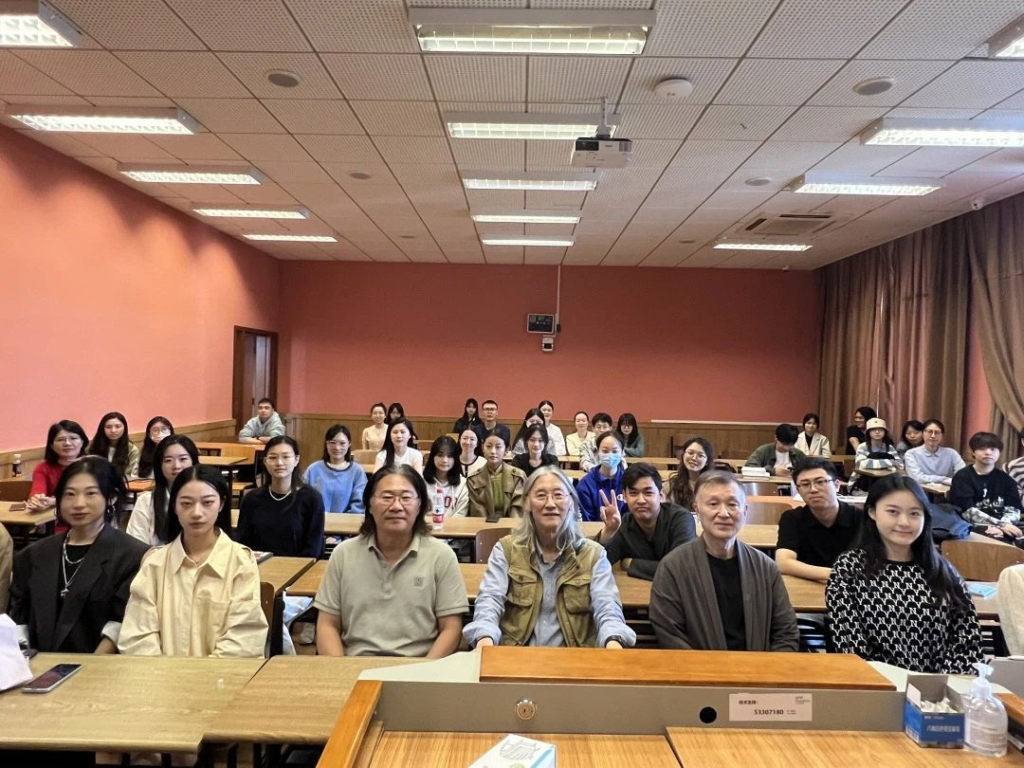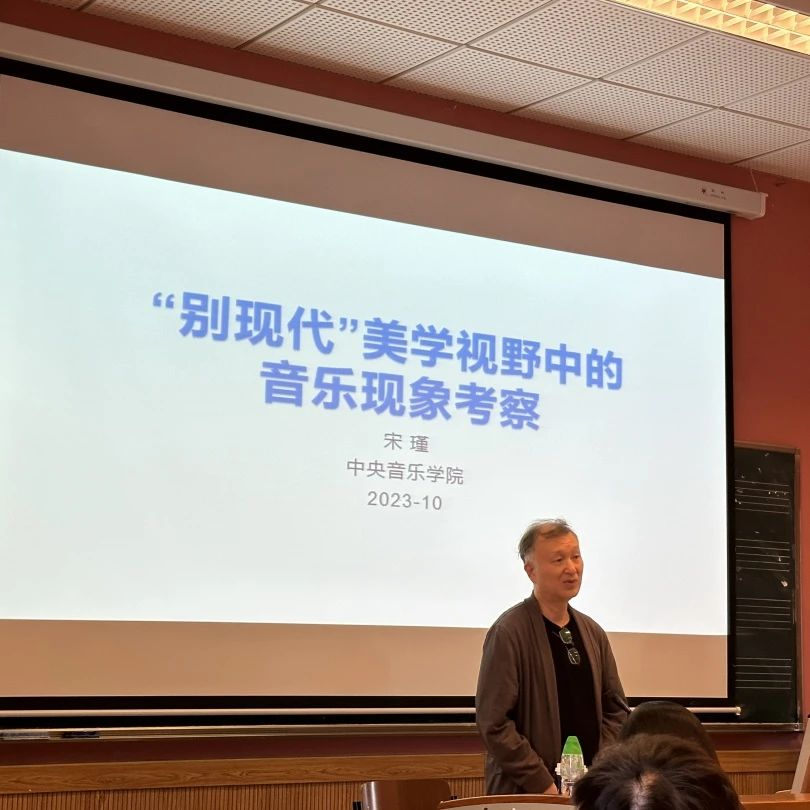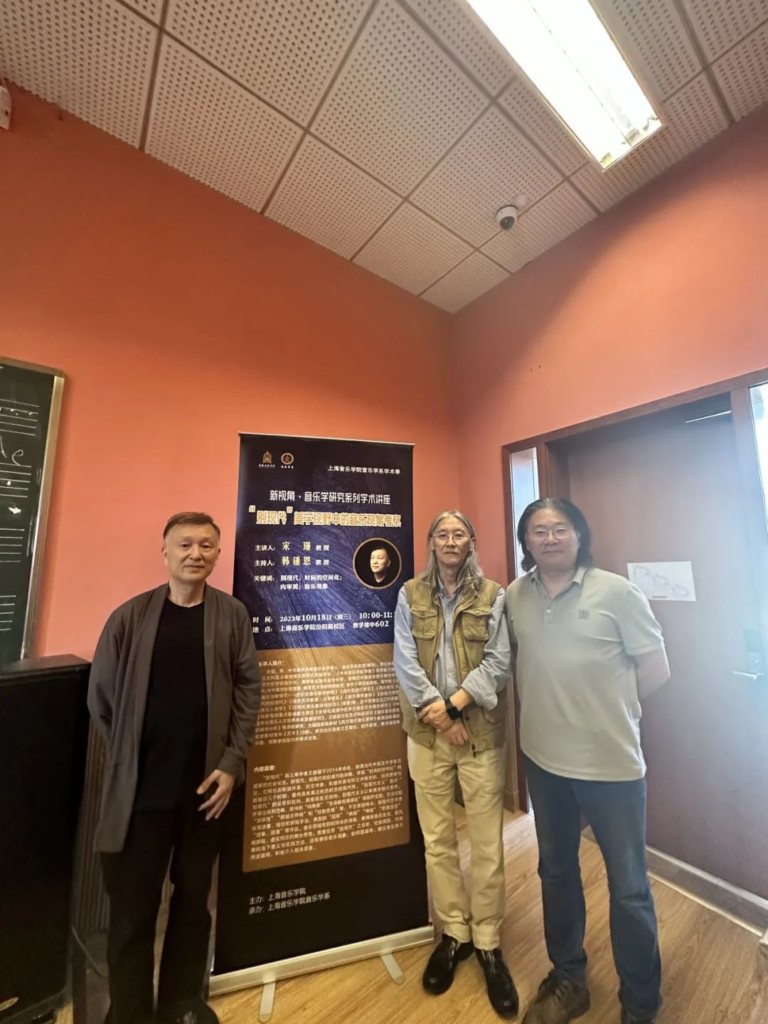An Examination of Musical Phenomena in the Perspective of “Bie-modern” Aesthetics
Profile:
On October 18, 2023, the academic season “New Perspectives-Musicology Research Academic Lecture Series” was held by the Department of Musicology of Shanghai Conservatory of Music, sponsored by Shanghai Conservatory of Music and undertaken by the Department of Musicology of Shanghai Conservatory of Music. Mr. Song Jin, professor of music aesthetics at the Central Conservatory of Music and president of the Society of Music Aesthetics of the China Music Association, was invited to give a lecture on the topic of “Examination of Music Phenomena in the Vision of “Bie-modern” Aesthetics” in the room 602 of the Central Building. The lecture was hosted by Prof. Han Zhong’en, a special expert of Shanghai Conservatory of Music. Prof. Feng Changchun, Deputy Director of the Department of Musicology of Shanghai Conservatory of Music, and teachers and students of the Department of Musicology attended the lecture.

Detail:
At the beginning of the lecture, Mr. Song Jin gave a brief introduction to the two “ruptures” in modern Chinese history. The first “rupture” was during the New Culture Movement, when a large amount of Western culture was introduced, and the cultural trend led to the literary and artistic demand for “new music”. The second “rupture” occurred after the Reform and Opening-up period, when a large amount of contemporary Western culture was introduced, leading to the emergence of “New Wave” composers such as Tan Dun, Qu Xiaosong, and Qin Wenchen.

As a result of these two “ruptures”, China’s contemporary cultural development is different from the Western historical process of “pre-modern,” “modern,” and then “post-modern,” as well as the gradual progression from pre-industrial to industrial and then post-industrial achievements. Rather, it is the direct and simultaneous introduction of the “modern” and “postmodern” achievements of the West. As a result, there is a coexistence of “pre-modern”, “modern” and “post-modern” in the fields of economic status quo, management dimension, daily life, and artistic and literary creation. Therefore, what kind of concepts should be used to define the state of contemporary Chinese culture? This is particularly important.
In order to address this phenomenon, Mr. Song Jin introduced the theory of “Bie-mordenism” proposed by Prof. Wang Jianjiang of Shanghai Normal University in 2014, and the phenomenon of research boom in foreign countries. He believes that the phenomenon of Chinese contemporary music can be approached from the perspective of “Bie-morden”.
“Bie-modernity”, meaning “a doubtful modernity” or “pseudo modernity”. Etymologically, the word “Bie” can be interpreted as “doubtful; dubious; unpredictable; unknown …… “, or as It can also be interpreted as “fake; disguised; impostor; impure; virtual”. In traditional literature, there is also the doctrine of “Bie”. Therefore, “Bie-modern” is also characterized by “specious modernity”. Therefore, “Bie-modern” refers to a social form in which the three social forms of modernity, pre-modernity and post-modernity are blended and coexist together, and in which all three attributes coexist, and it is a society in which modernity is packaged in the form of substantial non-modernity.
Mr. Song Jin mentioned that this “co-temporal society”, which is commonly found in the Third World countries, has to break the “coexistence” of the three social attributes of the present time through the development of the four-stage theory. This “coexistence” highlights the “spatialization of time” and thus enters into the “ephemeral state” of modernization, i.e., into world history with its linear succession.
Based on the above understanding of “Bie-modern”, “Bie-modernism” came into being in order to establish a kind of academic proposition and ideological tendency that can distinguish between true and false modernity, and to establish a real modernity by reflection and criticism. The fundamental meaning of Bie-modernism is to remove the pseudo-components of Bie-modernism like a knife removing bones. In addition, it inherits the excellent tradition of the ancient Chinese “Bie” theory, bases itself on the needs of China’s current reality, and carries on the innovation, ideological innovation, and theoretical innovation all the way to form a new “Bie” theory that is completely different from the traditional one.
Its methodology involves three main aspects. The first is “divergent thinking”, i.e. maximizing the subjective initiative of the researcher and the creative subject to form an independent philosophical-aesthetic theory. The second is “the Leap-forward Pause”, i.e. the realization of the finiteness of the prospect, which leads to a pause for reflection and an abrupt turn in the middle. The third is the “cutting theory”, that is, embedding the “cutting” link in the inheritance-innovation mode, and realizing the innovation and creation of new independent civilization property rights through the severance of tradition.
On the basis of the above theoretical definition, Mr. Song Jin firstly explains the main characteristics of the “Bie-modernity” culture. The main features are: the blending of multiple social forms, the intertwining of social control and free market, the randomness of choices brought by multiple values, and the Leap-forward Pause and stagnation of the development mode. Therefore, the transformation of ali-modernity or the way out lies in distinguishing between true and false modernity, eliminating randomness, removing pre-modernity, and real modernity.
After moving into the realm of aesthetics, Mr. Song Jin lists five “Bie-modern aesthetic forms”. These include “awkward dramas” characterized by slapstick, such as Xu Zheng’s Lost in Transit. Crazy dramas” characterized by “bloodthirsty” hilarity, such as Ning Hao’s “Crazy Race”. Divine dramas that distort and deconstruct history, such as various anti-Japanese dramas. Oddballs” characterized by ugly landmarks, including all kinds of collage-style buildings with no sense of aesthetics. As well as “glorification of the Qin and Qing dynasties”, characterized by the dramatization and exaggeration of the image of the heroes and rulers of the Ming dynasty, such as Zhang Yimou’s “Heroes”.
In terms of artistic creation methods, “Bie-modernist art” and “Bie-modern art” are characterized by pop, parody, collage and other visual arts. However, Mr. Song Jin pointed out that although the two have common aesthetic feature, in terms of ideological connotation, Mr. Song Jin said that the two are not the same. However, in terms of ideological connotation, “Bie-modernism Art” was born out of the reflection and criticism of “Bie-modern reality”.
In terms of the theory of aesthetics, “Bie-modernism” renamed the Chinese word “aesthetics” as “Aestheticology”. Instead of emphasizing specific aesthetic things, it emphasizes the importance of “aesthetic relationship”, and believes that “aesthetic sense” is dependent on the placement of aesthetic relationship to continuously generate. Therefore, in terms of aesthetic category theory, “Bie-modernism” puts forward the three categories of “self-regulated aesthetics”, “cultivated aesthetics”, and “inner aesthetics”. inner aesthetics”. It emphasizes the subject’s self-mobilization of subjective initiative to realize the aesthetic purpose, and at the same time enhances the inner aesthetic cultivation until it enters into the objectless “inner version” of aesthetics, i.e., it does not depend on the existence of the object, but establishes a kind of objectless aesthetic relationship or state through the subject’s introspection process.
“Bie-modernism also proposes the “Heroic Space Theory,” which envisions the coexistence of multiple views of the hero in the same space, realizing the hero’s transformation towards the future. The “Consumption Japan Theory” is put forward, i.e. the contradictory coexistence of material and spiritual consumption. The theory of “Life Equity”, in which people begin to avoid reality and enter a world of inner pleasure and spiritual beauty. This coexistence of contradictions, multiculturalism, and aesthetics, and the coexistence of otherness and self-differentiation is the structure of “Bie-modernism,” which is “the work of the opposite path.”
In terms of musical phenomena, Mr. Song Jin listed the musical works that embody the characteristics of “other-modernity” in contemporary music culture. These include: “yin-yang singing”, in which one person sings as a singer of a different gender or age at the same time. “Inorganic collage of pop songs”, i.e. traditional music directly pasted into pop tunes, such as “Don’t Want to Grow Up” and “Piano Injury”, which are pastes of Mozart’s “Symphony No. 40” and Tchaikovsky’s “June – The Boat Song”. “Musical Life on the Net,” in which avatars perform with real actors. “The audiovisual phenomenon of virtual and real coexistence”, i.e. the musical interpretation of the interweaving of virtual and real space caused by modern media technology, e.g. “Jasmine Flower”. “AI music”, i.e. de-artificialization in the performance presentation, e.g. Peking Opera Motion Vision.
Finally, Mr. Song Jin thought that it is not necessary to stick to the specific usage of the term “Bie-modern”, but to think more about the context and semantics. He left the questions of naming and social causes of “Bie-modern”, identifying, analyzing and criticizing the phenomenon of “Bie-modern” music for the students to think about after the class.
After the lecture, Mr. Song Jin answered two students’ questions.He Lewei from Shanghai Conservatory of Music, who is majoring in Composition Theory, thought that “Jasmine Flower” embodies the fusion of Chinese and Western musical cultures, but Mr. Song Jin held a negative attitude towards this. Liang Hao from Shanghai Conservatory of Music asked a question. Is “Bie-modern” a kind of “eclectic architecture” in Western design theory, which is in essence a kind of conservatism? In the process of the change of the Western music era, there is often the phenomenon of the coexistence of various styles, is it also a kind of “Bie-modernity”. Mr. Song Jin believes that the state of “Bie-modernity” is different from the period of Western music styles, in that the latter is dominated by a stylistic subject, whereas the cultural state of “Bie-modernity” is a non-subjective, pluralistic and overlapping state.
